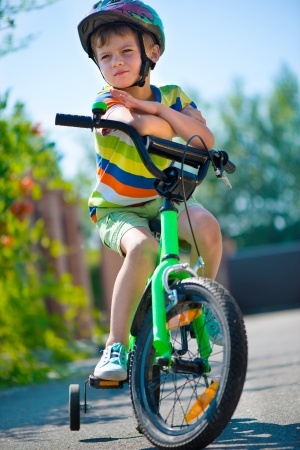How to Choose the Right Bicycle for Your Child
December 5, 2014 | Category: Bike Accidents | ShareNothing says Christmas like a shiny new bicycle under the tree. Bicycles rank high on children's "wish lists" as having bicycles represent adventure, independence and perhaps the mastery of new skills.
 The National Bicycle Dealers Association reports in its U.S. Bicycle Market 2013 report (latest available figures) that the industry size for 2013 is $5.8 billion.
The National Bicycle Dealers Association reports in its U.S. Bicycle Market 2013 report (latest available figures) that the industry size for 2013 is $5.8 billion.
With a market of this size there are many bicycles from which to choose. So, how do you choose the right bicycle for your child? The criteria may make the choice daunting.
"The following information is presented to assist in making the correct choice for your child and family," says Fort Myers Child Injuries Attorney, Randall Spivey of Spivey Law Firm, Personal Injury Attorneys, P.A. "Making the right choice when selecting a child's bicycle is an important first step in being sure children are safe on their bicycles and do not suffer injuries as the result of the 'wrong fit'."
What size is appropriate?
Although adult bicycles are selected by frame size, children's bicycles are referred to by the wheel size, according to Talbots Cyclery in California. Following are the sizes based on age:
Ages 2 to 3: 12-inch wheel balance bike
Ages 2 to 4: 12-inch wheels pedal bike with footbrakes/training wheels
Ages 3 to 6: 16-inch wheels pedal bike with footbrakes/training wheels.
Ages 5 to 8: 20-inch/Mini frame with footbrakes and/or 20" all-terrain style geared bikes with handbrakes.
Ages 8 to 12: 24-inch geared bike or 20" single speed BMX style bike.
Ages 10 & up: 26-inch wheel/12" to 16" frame all-terrain style bike.
In addition to age and height, it is recommended that the person purchasing the bicycle evaluate the coordination and cycling experience of the rider as well. An example that is given by Talbot is that a taller child which may lack confidence would do better with a smaller bicycle because he/she may feel more in control. Conversely, a younger coordinated child may be ready for a full-size bicycle.
Safety is most important. Children should not "grow into" bicycles. Experts recommend that the bicycle fit the child today. Bicycles which are too large for the rider may be dangerous and cause accidents.
Children need to be able to get on and off the bicycle safety. They need to be able to place both feet on the ground while sitting on the seat. With training wheels, it is all right if the child reaches the ground with his/her toes only as the training wheels provide the stability.
The handlebars must be in comfortable reach. When handlebars are out of reach, the bicycle rider may lose control. A child must be able to reach the brakes should the bicycle be equipped with hand brakes. He/she must also have the hand strength to operate the hand brakes. Should they not have the strength, the bicycle shop can adjust the brake system.
The American Academy of Pediatrics (AAP) recommends that children sit on the seat with their hands on the handlebars to test the right fit. "They should be able to place the balls of both feet on the ground. Also, children should straddle the center bar. They should be able to stand with both feet flat on the ground with about a 1-inch clearance between the crotch and the bar."
What "type" of bicycle?
When you go into any bicycle department in a store, you will see the choices of "type" of bicycle seem endless.
Sidewalk Bikes
For younger children there are "sidewalk" bikes which are not intended to be used on streets. They are used to get children accustomed to getting out of the house and riding with others.
BMX
When children get older, around 8 years of age, they may want a BMX model (Bicycle Moto Cross). These bikes are the most specialized with three different types:
- True BMX bike
- Freestyle bike
- Dirt jumper bike
Cruisers and Mountain Bikes
Cruisers and mountain bikes are also popular. Cruisers have wide handlebars and wide seats. Mountain bikes, although they have smaller wheels and frames, have many of the same features as adult bikes.
The need to select the right size and type bicycle for a child is made clear by medical professionals including MedicineNet.com, the online medical publishing company owned by WebMD. On its website is an article titled, "Buy the Right Bike for Your Child!" which reminds us, "A bike makes a great present for a child, but the wrong size bike can cause a child to lose control of it and be injured. Bicycle accidents can be serious or even fatal."
"When purchasing a bicycle for your child or anyone, be sure the one selected is not on a recall list. Check the Consumer Product Safety Commission (CPSC) website by clicking here Bike Recalls," reminds Attorney Spivey.
Fort Myers Accident Attorney, Randall L. Spivey is a Board Certified Trial Attorney – the highest recognition for competence bestowed by the Florida Bar and a distinction earned by just one (1%) percent of Florida attorneys. He has handled over 2,000 personal injury and wrongful death cases throughout Florida. For a free and confidential consultation to discuss your legal rights, contact the Spivey Law Firm, Personal Injury Attorneys, P.A., in Lee County at 239.337.7483 or toll free at 1.888.477.4839,or by email to Randall@SpiveyLaw.com. Visit SpiveyLaw.com for more information. You can contact Spivey Law Firm, Personal Injury Attorneys, P.A.in Charlotte County at 941.764.7748 and in Collier County 239.793.7748.

